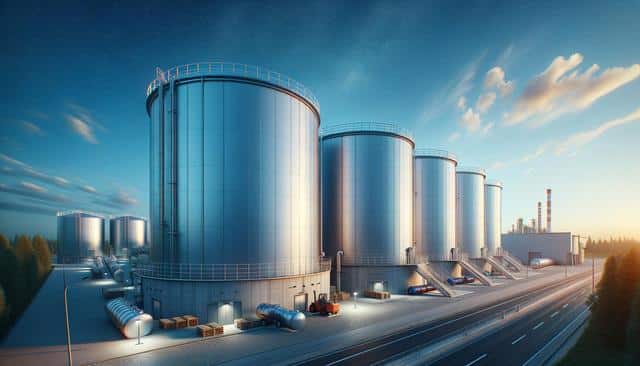
Understanding Storage Tanks: Types, Applications, and Installation Insights
Different Types of Storage Tanks and Their Purposes
Storage tanks come in various shapes, sizes, and configurations to meet specific requirements. Whether used in industrial, commercial, or municipal settings, each type serves a distinct function. A ground storage tank is typically installed at or below ground level and is widely used for storing potable or non-potable water. On the other hand, an elevated tank is commonly found in public water systems, positioned high above ground to utilize gravity for water distribution.
There are also specialized tanks designed for unique applications. For instance, hydrochloric acid storage tanks are engineered with corrosion-resistant materials due to the highly corrosive nature of the substance. Similarly, a thermal storage tank for chilled water system is essential in HVAC systems to store chilled water during off-peak hours and release it during peak demand, increasing energy efficiency and reducing operational costs.
Depending on the material stored, tank design considerations include:
- Material compatibility (e.g., steel, fiberglass, polyethylene)
- Pressure requirements
- Insulation needs
- UV and chemical resistance
Understanding the intended use of the tank is the first step in selecting the appropriate type and material.
Key Considerations When Installing Water Tanks
Installing water tank systems involves a series of considerations, from site selection to compliance with local regulations. The location must be accessible for maintenance and protected from potential contaminants. For ground storage tank installations, a stable foundation is critical to prevent shifting or settling over time. For elevated tanks, structural support and wind resistance are vital design factors.
Important steps in the installation process include:
- Site evaluation and soil testing
- Permitting and regulatory compliance
- Tank selection based on capacity and usage
- Safety and overflow controls
Proper installation not only ensures the longevity of the tank system but also plays a crucial role in maintaining the quality of the stored substance. Working with experienced professionals and manufacturers can help avoid common pitfalls during the setup phase.
Applications in Industrial and Environmental Settings
In industrial environments, storage tanks support the safe containment of chemicals, fuels, and wastewater. For example, wastewater storage tank systems are integral to treatment facilities, enabling the segregation and processing of effluents before discharge or reuse. These tanks are often constructed with coatings or liners to resist corrosion and chemical degradation.
In the energy sector, bulk fuel storage tanks are used to store large volumes of diesel, gasoline, or kerosene. These tanks meet stringent safety standards and often include features such as fire protection systems, leak detection, and secondary containment to minimize environmental risk.
Industrial storage applications often include:
- Process water storage
- Sludge containment
- Acid and chemical storage
- Fuel and oil reserves
These applications demand rigorous engineering and maintenance protocols to ensure safety and regulatory compliance.
Specialized Storage Solutions for Critical Needs
Some storage needs are particularly complex and require highly specialized solutions. For instance, hydrochloric acid storage tanks must be designed with non-metal materials or protective coatings to prevent tank degradation. Similarly, thermal storage tank for chilled water system installations are crucial in large commercial buildings to balance cooling demands and reduce energy consumption.
Specialized tanks often come with custom design features such as:
- Double-walled construction for leak prevention
- Advanced insulation for thermal regulation
- Automated monitoring systems
- Pressure and temperature relief mechanisms
These features help maintain the integrity of the stored material and provide enhanced operational control. Investing in high-quality, purpose-built tanks can result in long-term savings and more reliable system performance.
Maintenance and Safety Practices
Regardless of the type, all storage tanks require regular inspection and maintenance to function effectively and safely. Scheduled maintenance helps identify issues such as corrosion, leaks, or structural wear before they become critical. For tanks used in hazardous applications like bulk fuel storage or hydrochloric acid storage, monitoring systems and emergency protocols are especially important.
Best practices for tank maintenance include:
- Visual inspections for rust, cracks, and leaks
- Testing of safety features like pressure valves and alarms
- Routine cleaning to prevent buildup or contamination
- Documentation of inspections and repairs
Implementing a preventive maintenance schedule can extend the service life of the tank and ensure continued compliance with safety regulations, particularly in sectors dealing with hazardous or regulated materials.
Conclusion: Choosing the Right Storage Tank for Your Needs
Storage tanks are critical components across a broad range of industries and applications. Whether you need a ground storage tank for municipal water, an elevated tank for consistent pressure delivery, or a system for bulk fuel storage, selecting the right type is essential for safety, efficiency, and reliability. For specialized needs like hydrochloric acid storage or a thermal storage tank for chilled water system, working with experienced providers is key. Understanding the purpose, environment, and regulatory requirements will help guide your investment in a solution that stands the test of time.

